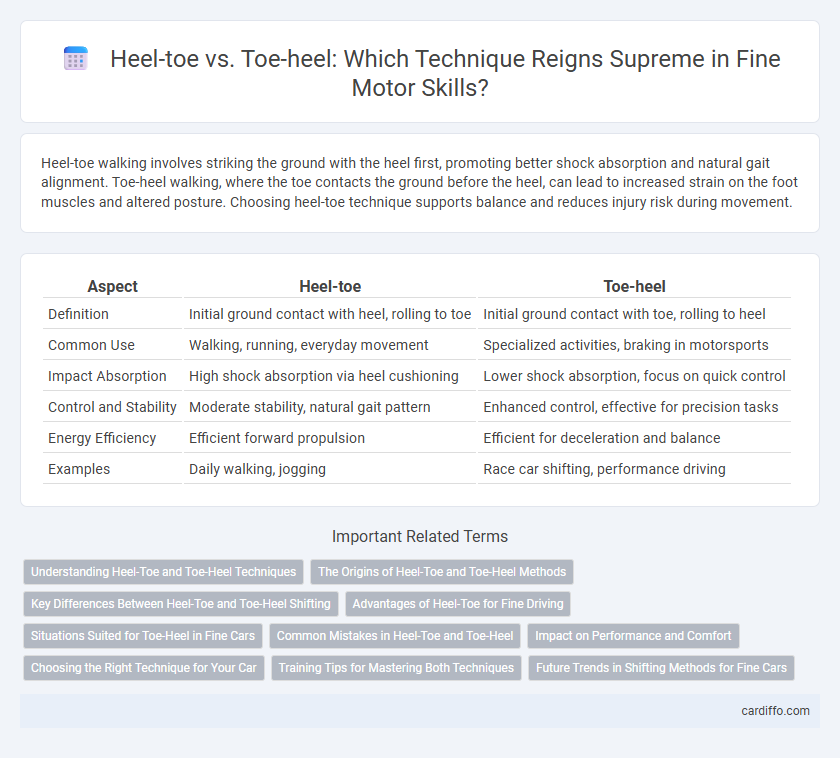Heel-toe walking involves striking the ground with the heel first, promoting better shock absorption and natural gait alignment. Toe-heel walking, where the toe contacts the ground before the heel, can lead to increased strain on the foot muscles and altered posture. Choosing heel-toe technique supports balance and reduces injury risk during movement.
Table of Comparison
| Aspect | Heel-toe | Toe-heel |
|---|---|---|
| Definition | Initial ground contact with heel, rolling to toe | Initial ground contact with toe, rolling to heel |
| Common Use | Walking, running, everyday movement | Specialized activities, braking in motorsports |
| Impact Absorption | High shock absorption via heel cushioning | Lower shock absorption, focus on quick control |
| Control and Stability | Moderate stability, natural gait pattern | Enhanced control, effective for precision tasks |
| Energy Efficiency | Efficient forward propulsion | Efficient for deceleration and balance |
| Examples | Daily walking, jogging | Race car shifting, performance driving |
Understanding Heel-Toe and Toe-Heel Techniques
Heel-toe technique involves landing on the heel first and rolling forward to the toe, promoting a smoother transition in running and braking motions. Toe-heel technique starts by striking the ground with the toe and then rolling back onto the heel, often used in specific athletic movements for enhanced control. Mastery of both techniques improves balance and efficiency in walking, running, and vehicle control tasks.
The Origins of Heel-Toe and Toe-Heel Methods
The Heel-toe method originated in traditional braking techniques used by skilled drivers to maintain balance and control during cornering by blipping the throttle while downshifting. The Toe-heel technique evolved as an adaptation to enhance pedal efficiency, where the ball of the foot operates the brake while the heel simultaneously presses the throttle. Both methods stem from motorsport disciplines, emphasizing precise throttle modulation and seamless gear transitions for optimal vehicle performance.
Key Differences Between Heel-Toe and Toe-Heel Shifting
Heel-toe shifting involves braking with the heel while blipping the throttle with the toe to smoothly downshift, maintaining engine revs and preventing drivetrain shock. Toe-heel shifting reverses this technique, using the toe for braking and the heel for throttle blips, often favored in specific pedal setups or driving styles. Key differences include foot positioning, muscle engagement, and suitability for different vehicle pedal configurations.
Advantages of Heel-Toe for Fine Driving
Heel-toe downshifting enhances vehicle control by allowing smoother and more precise gear changes during cornering, reducing the risk of wheel lockup and maintaining optimal traction. This technique optimizes engine braking, which stabilizes the car's balance and improves overall driving finesse on fine or technical roads. Mastering heel-toe downshifting results in better consistency and faster lap times for performance-oriented drivers.
Situations Suited for Toe-Heel in Fine Cars
Toe-heel downshifting is ideal in fine cars during spirited driving on winding roads where precise control of speed and smooth gear transitions enhance performance. This technique suits situations requiring engine braking without unsettling the vehicle's balance, such as approaching sharp corners or descending steep grades. Fine cars with responsive throttle response and advanced drivetrains benefit most from toe-heel for maximizing traction and maintaining stability.
Common Mistakes in Heel-Toe and Toe-Heel
Common mistakes in heel-toe shifting include improper timing between the heel and toe movements, causing jerky gear changes and increased wear on the clutch and gearbox. Toe-heel downshifting errors often arise from using the wrong part of the foot, leading to insufficient rev-matching and engine over-revving. Mastering precise foot placement and timing reduces mechanical stress and ensures smooth, efficient gear transitions.
Impact on Performance and Comfort
Heel-toe running promotes natural shock absorption by landing on the heel first, reducing joint stress and enhancing overall comfort during long-distance runs. Toe-heel running, often more common in sprinting, improves propulsion and speed but can increase strain on calf muscles and the Achilles tendon. Selecting the proper technique based on running goals is crucial for optimizing performance and minimizing injury risk.
Choosing the Right Technique for Your Car
Heel-toe downshifting enhances smooth gear transitions and maintains engine RPM, ideal for performance driving and preventing wheel lock during braking. Toe-heel technique offers greater precision and control, making it suitable for high-speed cornering and racing applications where optimal traction is crucial. Selecting the right method depends on your car's transmission type, driving style, and specific road conditions to maximize safety and performance.
Training Tips for Mastering Both Techniques
Heel-toe and toe-heel techniques require precise foot positioning and weight distribution for effective execution. Training tips include practicing slow, controlled movements to build muscle memory and incorporating balance exercises to enhance stability. Consistent repetition and focus on smooth transitions between heel and toe strikes improve overall technique mastery.
Future Trends in Shifting Methods for Fine Cars
Future trends in fine car driving emphasize a growing preference for heel-toe shifting due to its superior control and smooth gear transitions, enhancing performance during spirited driving. Advanced driver-assistance systems and electronic rev-matching technology are increasingly integrated, reducing the need for manual throttle blips in toe-heel downshifting. These innovations indicate a shift toward more intuitive and efficient shifting methods, blending traditional technique with modern automation for optimal driving dynamics.
Heel-toe vs Toe-heel Infographic

 cardiffo.com
cardiffo.com